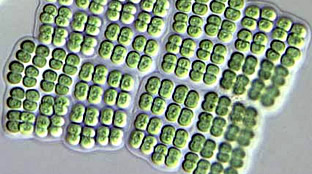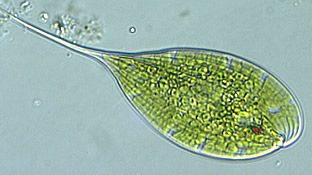What are algae?
Algae are a very large, diverse
group of organisms
that photosynthesize.
The group “algae” include a heterogeneous collection of organisms. In other words, few of the algae are closely related to one another and they belong to separate taxonomic groups. Rather than being members of the same evolutionary lineage, the algae share little history in common. Algae are so different from one another that they include single cells that are microscopic, to huge seaweeds, over 50 meters in length.
The group “algae” is more a matter of convenience to humans. Algae are all able to photosynthesize, that is, they use energy from the sun (photosynthesis) to make sugars inside the cell. Like photosynthetic plants, algae contain chlorophyll to gather energy. The molecule, chlorophyll, is remarkable for its ability to use water, carbon dioxide, and light to create sugar (food), oxygen and water. Most algal species are oxygenic phototrophs, meaning they use oxygen and light to produce sugars. Although (almost) all algae are photosynthetic, they contain different pigments. Phycoerythrin, phycocyanin, fucoxanthin and peridinin are all pigments contained in different groups of algae. They function to absorb light energy in algae and also give each group its characteristic color.
There are over 200,000 species of algae that have been described, from a wide variety of habitats. Algae live primarily in aquatic habitats including oceans, lakes streams, and puddles, but they are also found in soil, growing on trees, and in rocks. Algae form important symbiotic relationships. For example, lichens are composed of an association of fungi and green algae (or in some cases, cyanobacteria). Coral reefs are composed of an association of an invertebrate and a dinoflagellate. Algae are vital to all life on earth, because they form the base of many aquatic food webs. For example, algae in the oceans are eaten by krill, tiny crustaceans, which are food for whales, fish, penguins, other seabirds, manta rays, and squid. We (humans) eat algae, too. Components of algae are included in foods such as ice cream, mayonnaise, pudding, whipped cream, chocolate milk, and cottage cheese to make them thick and creamy. Algae are important to many organisms, at a global level, each day all life on earth is linked to the algae.

Cladophora (green) with diatoms (smaller, brown). Photo: Kalina Manoylov.

Chrysophyta Dionbryon. Photo: Jason Oyadomari.

Microcystis.

Phacus.Photo: Jason Oyadomari.
Algae Phyla in Rocky Mountain Lakes
In approximate order of diversity:
| Row | Name | Cell | Chlorophyll | Pigments | Storage | Flagella |
|---|---|---|---|---|---|---|
| 1 | Bacillariophyta (Diatoms) |
Eukaryotic | a and c | Fucoxanthin and ß carotene | chrysolaminarin and lipids | 1, reproductive cells only |
| 2 | Chlorophyta (Green algae) |
Eukaryotic | a and b | None | starch | 0-4 |
| 3 | Cyanophyta (Blue-green algae) |
Prokaryotic | a | Phycocyanin, Allophycocyanin | starch, granules, polyhedral bodies | None |
| 4 | Chrysophyta (Golden algae) |
Eukaryotic | a, c1, and c2 | Fucoxanthin or vaucheriaxanthin | chrysolaminarin | 2 unequal |
| 5 | Cryptophyta (Cryptomonads) |
Eukaryotic | a and c2 | Phycocyanin or Phycoerythrin | starch and lipids | 2 equal |
| 6 | Dinophyta (Dinoflagellates) |
Eukaryotic | a, c1, and c2 | Peridinin | starch and lipids | 2 unequal |
| 7 | Euglenophyta (Euglenoids) |
Eukaryotic | a and b | None | paramylon | 1-2 emergent |
| 8 | Haptophyta (Prymnesiophytes) |
Eukaryotic | a, c1, c2, and sometimes c3 | Fucoxanthin, ß carotene, diadinoxanthi, diatoxanthin | chrysolaminarin, paramylon | 2 equal + haptonema |
| 9 | Other (Other) |
Prokaryotic |

